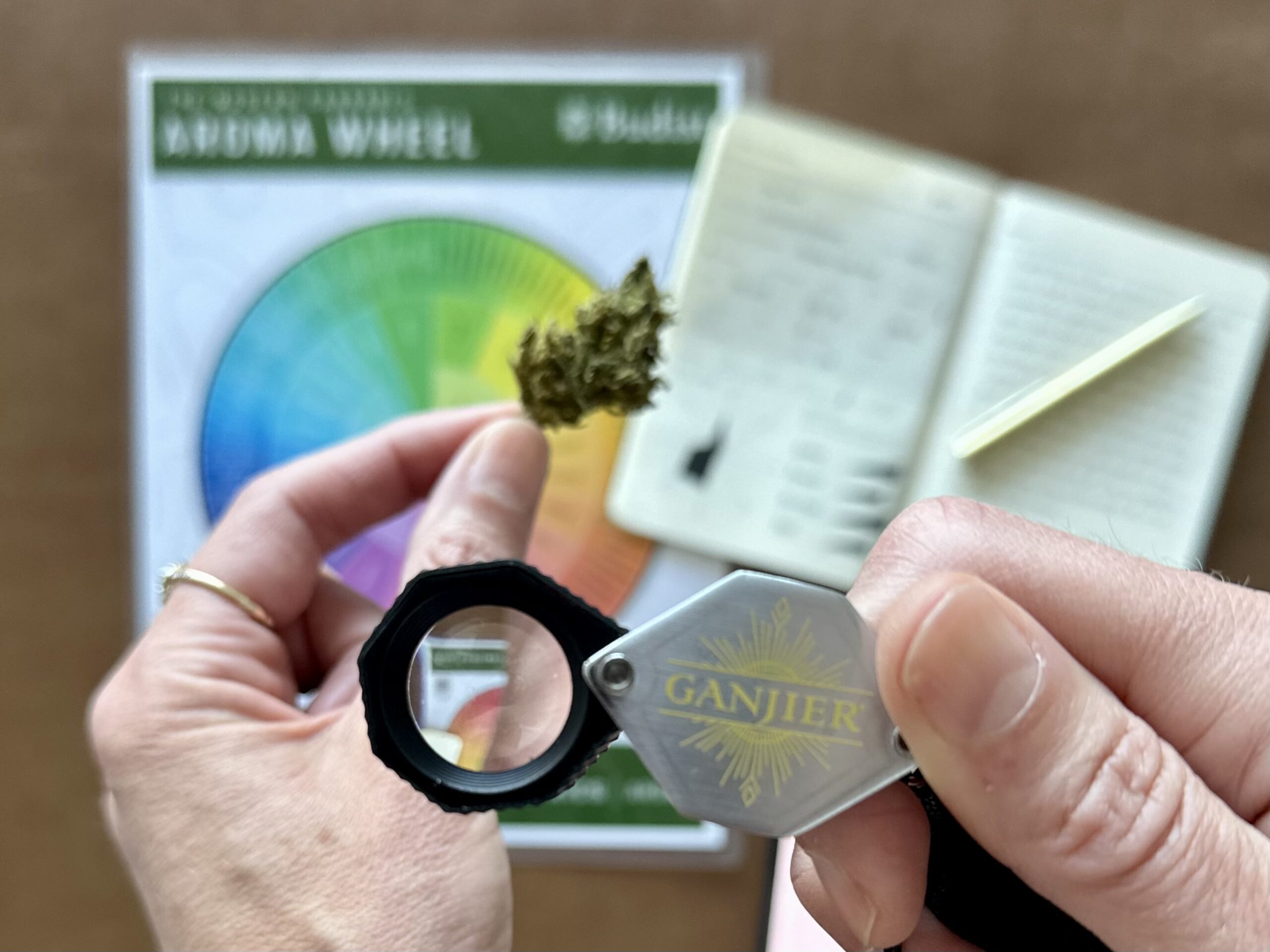How to Rate & Review Cannabis Products

At Budist, our mission is to celebrate the cannabis producers who are dedicated to quality craftsmanship, and one of the ways we do this is through cannabis reviews. There are two kinds of reviewers on Budist: the professional cannabis critic and the enthusiast.
Every cannabis critic has a unique voice. Your voice is a culmination of your experiences inside and outside of cannabis, as well as your consumption preferences and desired use cases. A review of a cannabis product should be fair, knowledgeable, and empowering, and should ideally follow a standardized approach to ensure consistency in the market. Here’s how to write a cannabis review like a professional Budist.
What Does a Budist Cannabis Review Look for?
Our Budists aren’t just looking for the highest potency products-they’re looking for the highest quality. In addition to the standard review criteria-such as aroma, flavor, appearance, and effects-Budists also look beyond the product itself. They consider the cultivation methods, the region where it was grown, and how it was dried, cured, packaged, or extracted. They assess product efficacy, its value relative to the price point, and whether it satisfies its intended use case. Budists undergo this thorough evaluation using our 100-point rating system and review criteria-and you can too.
High-quality cannabis products are made with care and craftsmanship, an intangible quality that is the differentiator between an average product and an exceptional one.
Budist Cannabis Review Criteria
At Budist, we break our reviews down into four simple sections:
- A rating out of 100 points
- 2-4 paragraphs on the product: the experience, brand story, production methods, price category, and use case.
- Tasting notes: appearance, aroma, flavor, and effect.
- Photos of the packaging, its contents, and the ideal use case.
Following this outline ensures that reviews get to the point, are easy to understand, and always follow the same criteria.
What Does a Cannabis Review Include?
A successful cannabis review touches on every element of the experience with a certain product, from the moment you crack open the package to hours later. This can include, but is not limited to, the following factors:
Cannabis Features
Cannabis products, especially flower, come in a wide range of aromas and flavors. These unique features are crucial to understand to properly assess cannabis. There is the primary aroma and the secondary. There is the initial burst of flavor and what lingers on the back of your tongue. It’s not enough to notice that a strain is earthy – does it smell like dry pine or the rich scent of wet dirt? Is a citrus aroma lemon, orange, or something unusual like burnt grapefruit?
The appearance of the flower is similarly complex. Is the bud dense or sparse? Is it coated in trichomes and are the heads clear, milky or intact? Is it overly trimmed or contain too many leaves? Is the texture not too moist and not too dry, but appropriately sticky and squishy? Or in the case of concentrates, what is the texture, color and clarity? Is it greasy, wet or dry?
In order to dig deep into the features of a cannabis product, the critic must have a refined palette and discerning eye. They must be able to distinguish between similar scents to dig down to the exact aroma emanating from a flower. A good example outside of cannabis is BBQ sauce: critics can tell the difference between a vinegar-based sauce and a mustard-based sauce with a sniff. Professional cannabis critics have even been known to use other aromatic products-like culinary herbs and spices-to calibrate their senses, especially when judging multiple strains at once.
Features can also include the packaging of the cannabis product and the ease of use: how easy is it to open and consume? Are there instructions for use and dosage (which is particularly important for medicinal products)? It’s also worth noting if the packaging design is creative and innovative. Although this doesn’t factor into assessing product quality per se, it may be of importance if the product appears luxe on the outside and mediocre on the inside. Consumers need to know if the product fails to deliver on the promises it makes on its packaging.
Cannabis Benefits
The cannabis plant is capable of producing a wide range of experiences and explaining these well is crucial to a good review and setting consumer expectations. A Budist can paint a picture of the experience: whether it was energizing or sedating, how strong the euphoria was, where they felt the effects the most, and the timeline of the experience. Some products or strains hit quickly while others have a slow creeping effect.
It also matters how the reviewer found the experience: was it pleasant? Intense? Lackluster? Best suited for afternoon use and not a wake and bake? Did it relieve any pain or noticeable inflammation in the body? Was it easy to focus and dive into a creative task or did it make you want to dance around your kitchen?
Tolerance and intention matter in the benefits too. While many cannabis lovers enjoy an intensely high experience, there are also those who do not and are actively seeking lower-potency, more gentle strains or formulations. If a reviewer was hoping for a stronger potency, can they still find a use case for lower potency products? The diverse benefits of cannabis are matched by the diversity of the goals of cannabis consumers.
Other benefits worth noting are social and environmental. Is the product certified organic or sustainable?-meaning it may have benefits for both personal health and the planet. Some products give a portion of their proceeds to support social causes, which might resonate with consumers who make values-based purchasing decisions. It’s important to highlight these factors in a product review because it can guide consumers to making decisions that align with their personal values and lifestyle choices.
Brand Story
Who made the product? What brought them to cannabis? What is their mission and values? Many consumers want to find brands that are family-owned, use regenerative farming methods, or that serve a particular cause or community. Diving into a brand story helps paint a more complete picture of a cannabis product by highlighting its background, purpose, and reason for being. People want to know more about the brands they’re supporting, especially in cases where there’s a unique and compelling story that the world needs to hear.
Strain Lineage
Every strain has a unique story behind its genetics. Some strains come from distant shores and have perfectly preserved genetic legacies while others have been bred and cross-bred and bred again. Is it a landrace strain? Does it originate from dry mountainous regions or wet equatorial climates? Which way does the hybrid lean, and would the effects of the strain align with typical sativa or indica expectations? Does it have any notable parent strains whose effects shine through? While tracing the lineage of cannabis plants is not an exact science, looking through the family tree can help set product expectations.
Production Process
How was the product cultivated or manufactured? Sungrown in no-till soil? Using solvent or solventless extraction techniques? In small batches or high volume production facilities? With synthetic inputs or all-natural ingredients? High-quality cannabis products are typically made with clean methods using high-touch, handcrafted, or small batch production techniques. But this isn’t always the case, so it’s important to view the process holistically-from seed to sale-to determine if the process yields an end product that ultimately serves the needs of the customer.
Efficacy
What value does the product promise? Some people come to the plant for medical reasons: dealing with pain in the body or stimulating appetite. Others come for help relaxing, letting go of stress, or feeling aroused. Still others just want to get as high as possible for as little money as possible with good quality products. Does the cannabis product reliably deliver on its stated promise? The answer to this question can make or break a review.
Integrity
Was something wrong with the product? The answer to this is (hopefully) no, but things happen sometimes. Perhaps flower was left to dry for too long or machine-trimmed. Life happens too – sometimes cannabis products get forgotten in cars or left in plastic bags that aren’t sealed properly. These aspects influence the quality and experience and are important to acknowledge. It’s also important to note that product defects might be the result of how it was stored, transported, or handled after it left the production facility, so it may not be the fault of the brand.
These points don’t have to be addressed individually. A good critic can weave a compelling narrative that touches on the most important points, either in the tasting notes or the review section itself.
Finding Quality Cannabis Across Price Points
A cannabis critic also knows that it’s not just about top-shelf products. Quality cannabis can be found across price points, and elevating the conversation around this plant requires us to include all use cases. Expectations for a $2.50 preroll may be different than a $25 one, but shopping for cannabis on a budget shouldn’t mean sacrificing quality or efficacy. If it gets the job done for less, there is value in that for many cannabis consumers.
Above all, it’s important to remember that a good cannabis review does not need to be long-winded or written at an academic level. Cannabis is for everyone. A good review of cannabis products helps consumers make informed decisions by highlighting key points in a fair, balanced, and easily readable way. Our goal is to celebrate the people and producers of high-quality cannabis products, which means seeking out the exceptional, but never being exclusionary.
The Budist 100-Point Review System
Cannabis must be judged on a fair scale that uses the same criteria from product to product. While the exact scoring criteria must shift based on product category, each product that falls within that category will be judged on the same merits.
Using a 100-point review system allows for more nuance in cannabis reviews. A critic can dive deeply into what is exceptional and what is not in a given product, sharing feedback on products that are good, but could be better, and those that are simply exceptional. Learn more about our 100-point rating system in this blog.
Why Write Cannabis Reviews?
Just because you love cannabis doesn’t mean you feel a calling to write reviews. If you’re looking for unbiased and clear reviews, Budist is here for that.
Critiquing cannabis products is a great way to get to know both the plant and your endocannabinoid system better. Reviewing cannabis products goes a step further than enjoying them, asking you to consider what makes cannabis great or efficacious, personally and as a whole, remembering there are many use cases.
Reviewing your weed products makes you sit with them for longer, considering all aspects from seed to sale. It can help you identify patterns in your own preferences and become better equipped to seek out higher-quality products without a large investment. A good cannabis reviewer knows their own preferences and keeps in mind how many reasons there are that people turn to this plant.
Cannabis reviews serve an important purpose, giving feedback to producers and guidelines to consumers. In the dark days of prohibition, it was challenging to openly write about cannabis usage because of the legal risk. But today, with the abundance of new legal markets opening every year, it is high time we elevate the conversation away from simple THC potency to include all of the complexities that make this plant exceptional. Budist, as an organization, aims to elevate the cannabis conversation with expert reviews, open dialogue, and a community of connoisseurship.
